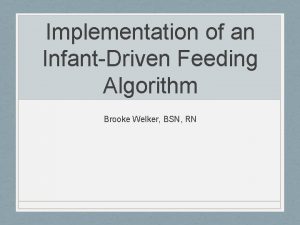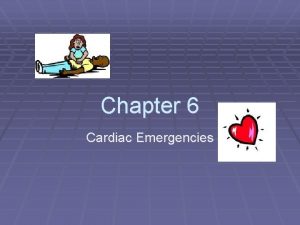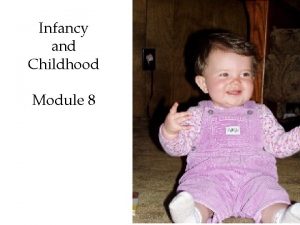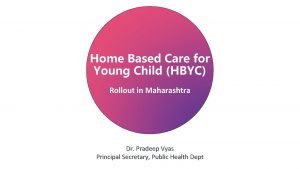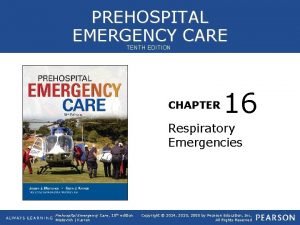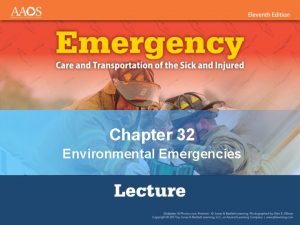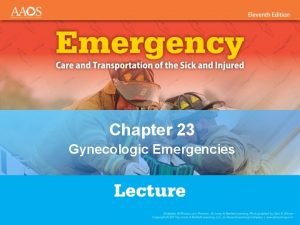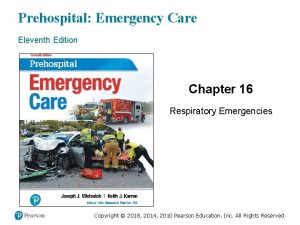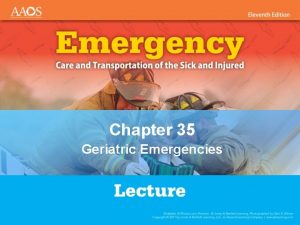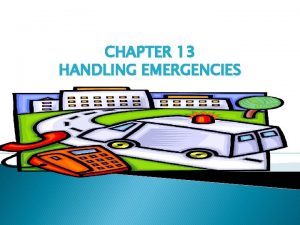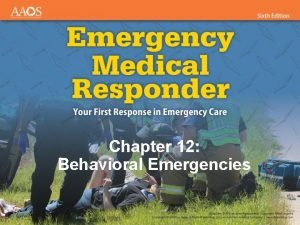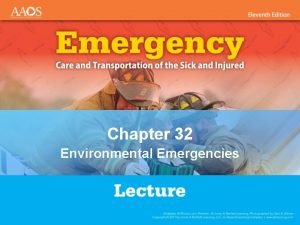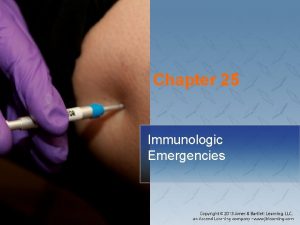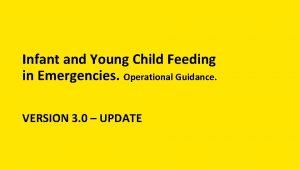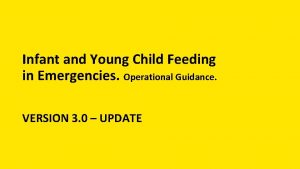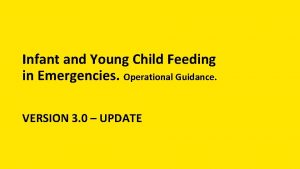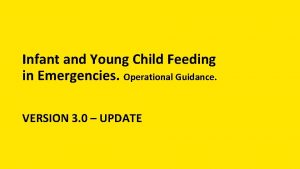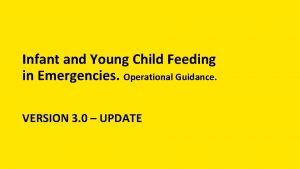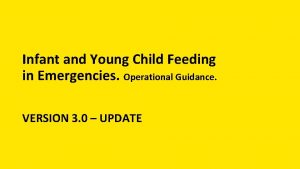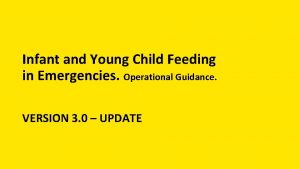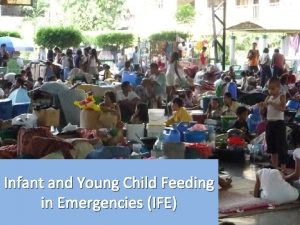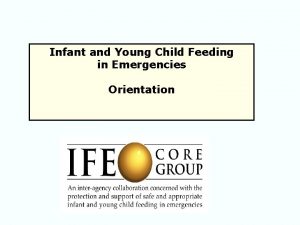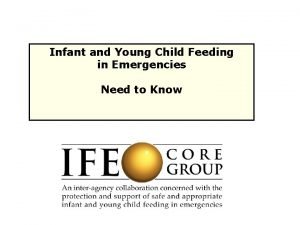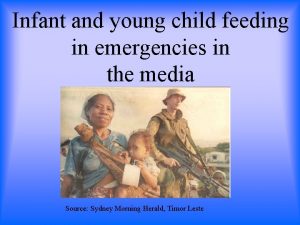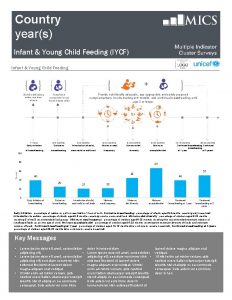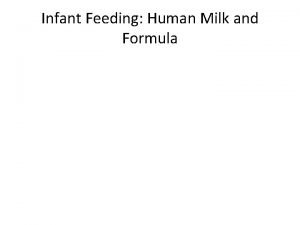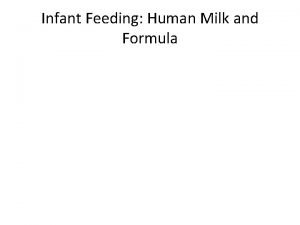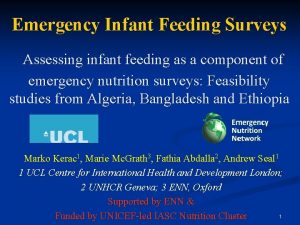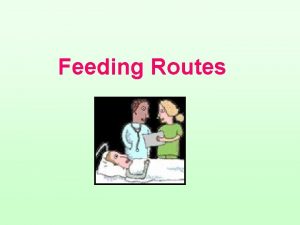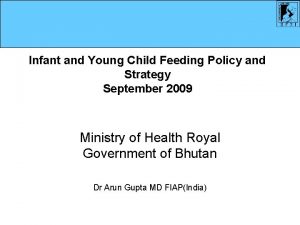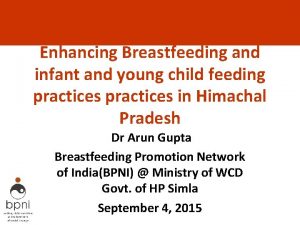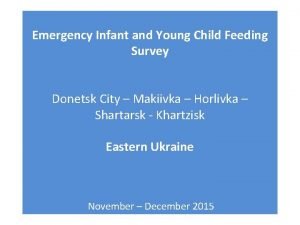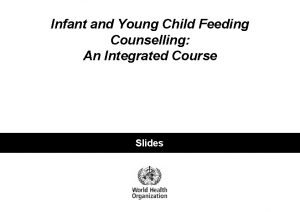Infant and Young Child Feeding in Emergencies Operational





























- Slides: 29

Infant and Young Child Feeding in Emergencies. Operational Guidance. VERSION 3. 0 – UPDATE

The Operational Guidance on IFE Aim To provide concise, practical guidance on how to ensure appropriate infant and young child feeding in emergencies (IFE) Scope Applies to emergency preparedness, response and recovery worldwide Target Groups Infants and young children aged 0 -23 months and pregnant and lactating women (PLW) Intended for Policy-makers, decision-makers and programmers working in emergency preparedness, response and recovery across sectors and disciplines.

Version 3 Updated by: Co-led: Coordinated by: Funded by: 2001 Version 1. 0 The IFE Core Group ENN and UNICEF ENN USAID/OFDA (ENN) 2006 Version 2. 0 2007 Version 2. 1 2010 Addendum ed 3 s r do ion 23. 2 n E solut e Ar WH 2017 Version 3. 0

V 3. 0 Process March 2016 • IFE Core Group Meeting: Interview findings shared, gaps in content and process agreed Feb 16 – Sept 17 Dec 2017 • Consultation IFE Core Group Experts Experiences & resources SPHERE • IFE Core Group Meeting: Dissemination & roll out action plan

V 3. 0 What has stayed the same? • Layout • Headings • Most of existing guidance • Terminology of IFE • Availability in English, French and Arabic KEY POINTS PRACTICAL STEPS (1 – 6) 1. Endorse or develop policies 2. Train staff 3. Co-ordinate operations 4. Assess and monitor 5. Protect, promote and support optimal IYCF with integrated multi-sector interventions 6. Minimise the risks of artificial feeding EMERGENCY PREPAREDNESS ACTIONS New KEY CONTACTS REFERENCES Expanded DEFINITIONS Expanded ANNEX 1: Multi-sectoral content New ACRONYMS New

V 3. 0 Revisions - Programming • Updated to reflect latest global guidance (published and upcoming) • Greater programmatic detail in all sections • Greater and more balanced content to address needs of non-breastfed infants • More comprehensive content on complementary feeding • Introduction of new concepts e. g. human milk banks • Considers situations where OG-IFE recommendations cannot be immediately met • More content on emergency preparedness • Summary key points updated

V 3. 0 Revisions – Roles & Responsibilities • Greater emphasis on the lead role of government in preparedness and response • Greater clarity on the respective roles and responsibilities of UN agencies • Greater coverage of sectors beyond nutrition and more explicit actions to take • Incorporated accountability to affected populations • Reflects significantly evolved operational environment

V 3. 0 Revisions – References, Resources, Terminology • More extensive list of supporting references and resources • Greater referencing of recommendations and definitions • More extensive list of definitions • Changes, and additions, to terminology • • • Optimal IYCF Recommended IYCF HIV Risk Assessment Donor Human Milk Bank Cluster Lead Agency Lipid-based nutrient supplement (LNS)

1: Endorse or develop policies Key provisions regarding IFE should be reflected in government, multi-sector and agency policies and should guide emergency responses. 2: Train staff Sensitisation and training on IFE is necessary at multiple levels and across sectors.

3: Coordinate operations Capacity to coordinate IFE should be established in the coordination mechanism for every emergency response. Government is the lead IFE coordination authority. Where this is not possible or support is needed, IFE coordination is the mandated responsibility of UNICEF or UNHCR, depending on context, in close collaboration with government, other UN agencies and operational partners. Where all provisions of OG-IFE cannot be immediately met, context-specific guidance on appropriate actions and acceptable ‘compromises’ should be provided by the IFE coordination authority and mandated UN agencies. Timely, accurate and harmonised communication to the affected population, emergency responders and the media is essential

4: Assess & Monitor Needs assessment and critical analysis should determine a context specific IFE response § Pre-crisis data § Rapid decision-making and action § Early needs assessment § In depth assessment § Monitoring It is essential to monitor the impact of humanitarian actions and inaction on IYCF practices, child nutrition and health; to consult with the affected population in planning and implementation; and to document experiences to inform preparedness and future response.

5: Protect, promote and support optimal IYCF with integrated multi-sector interventions Immediate action to protect recommended infant and young child feeding (IYCF) practices and minimise risks is necessary in the early stages of an emergency, with targeted support to higher risk infants and children § General § Breastfeeding support § Infants who are not breastfed – incl. relactation, wet nursing, donor human milk, BMS § Complementary feeding § Micronutrient supplementation § HIV and infant feeding § Infectious disease outbreaks

5: Protect, promote and support optimal IYCF with integrated multi-sector interventions In every emergency, it is necessary to assess and act to protect and support the nutrition needs and care of both breastfed and non-breastfed infants and young children. It is important to consider prevalent practices, the infectious disease environment, cultural sensitivities and expressed needs and concerns of mothers/caregivers when determining interventions In every emergency, it is important to ensure access to adequate amounts of appropriate, safe, complementary foods and associated support for children and to guarantee nutritional adequacy for pregnant and lactating women.

5: Protect, promote and support optimal IYCF with integrated multi-sector interventions Multi-sector collaboration is essential in an emergency to facilitate and complement direct infant and young child feeding (IYCF) interventions. Actions are included for: Health Adolescent Services WASH FSL Child Protection ECD Disability Shelter Cash Social Protection Agriculture Logistics WASH: Water, Sanitation and Hygiene, FSL: Food Security and Livelihoods, ECD: Early Childhood Development

6: Minimise the risks of artificial feeding In emergencies, the use of breastmilk substitutes (BMS) requires a context-specific, coordinated package of care and skilled support to ensure the nutritional needs of nonbreastfed children are met and to minimise risks to all children through inappropriate use § Donations in emergencies § Artificial feeding management § BMS supplies § BMS specification § Procurement of BMS supplies, feeding equipment and support § Distribution of BMS Donations of BMS, complementary foods and feeding equipment should not be sought or accepted in emergencies; supplies should be purchased based on assessed need. BMS, other milk products, bottles and teats should never be included in a general distribution.

Emergency preparedness …is critical to a timely, efficient and appropriate IFE response Examples from Box 1: Emergency Preparedness Actions POLICY TRAINING COORDINATION Develop preparedness plans on IFE Prepare orientation material for use in early emergency response Develop terms of reference for IFE coordination in a response ASSESS AND MONITOR ARTIFICIAL FEEDING MULTI-SECTOR INTERVENTIONS Prepare key questions to include in Examine national legislation early needs assessment related to food and drugs, particularly importation Communicate government position on not seeking or accepting donations

**INSTRUCTION SLIDE** The following slides cover implications of the revisions in the Operational Guidance on IFE for stakeholders involved with Food Security and Livelihoods in Emergencies. Please delete slides that are not applicable to your audience and cross reference to internal documents and processes where relevant.

Implications for…FSL is a key sector to sensitise and work with on IYCF. 3. 6 Coordinate with other sectors to identify opportunities for multi-sector collaboration in needs assessment and programming and to inform sector policies, actions plans and risk management regarding IFE. 3. 4 The level of coordination, including whether a dedicated IFE coordinator is necessary, will depend on the context. Wherever possible, support government to fulfil their IFE coordination responsibility and work with existing country-level structures and mechanisms. Identify or locate IFE coordination capacity within the most relevant sector coordination mechanism, such as nutrition, health or food security.

Implications for…FSL 4. 2 Explore opportunities to include IYCF questions in other sector needs assessments and draw on relevant multi-sector data. In multi-sector assessment teams, ensure one person has received basic orientation on IFE. 4. 5 Nutrition information may also be obtained through joint nutrition and food security assessments such as Joint Approach to Nutrition and Food Security Assessment (JANFSA); Comprehensive Food Security and Vulnerability Analysis (CFSVA); and Food Security and Nutrition Monitoring Systems (FSNMS). 4. 6. 1 Key contextual data to consider for an IFE response includes household food security - incl. access to appropriate complementary foods

Implications for…FSL 5. 22 Key considerations in determining complementary feeding response include pre-existing and existing nutrient gaps; seasonality; socio-cultural beliefs; food security; current access to appropriate foods; quality of locally available complementary foods, including commercial products; compliance to the Code and with WHO Guidance on ending inappropriate promotion of foods for infants and young children of available products; cost; proportion of nonbreastfed infants and childrenhh; reports of children with disability-associated feeding difficulties; maternal nutrition; WASH conditions; the nature and capacity of existing markets and delivery systems; national legislation related to food and drugs, particularly importation; and evidence of impact of different approaches in a given or similar contexts.

Implications for…FSL 5. 23 Complementary food support options/considerations include: • • • Cash or voucher schemes to purchase nutrient-rich foods and/or fortified foods that are locally available. Distribution of nutrient-rich foods or fortified foods at household level. Provision of multiple-micronutrient fortified foods to children aged 6 -23 months and PLW through BSFP Home fortification with micronutrient supplements, e. g. MNPs or other supplements. Livelihood programmes and safety net programmes for families with children < 2 and/or PLW. Use of animal milk and products. (see 5. 25) Provision of non-food items and cooking supplies (including domestic energy); Access to communal food preparation areas where household facilities are lacking; Advice on safe food handling; Protected eating and playing spaces.

Implications for…FSL 5. 25 Where animal milk is a significant feature of child diets, such as in pastoral communities, it is important to establish how to safely include milk products as part of a complementary diet. Milk products can be used to prepare complementary foods for all children over six months of age. Recommend to breastfeeding mothers not to displace or substitute breastmilk with animal milk. Pasteurised or boiled animal milk may be provided to non-breastfed children over six months of age and to breastfeeding mothers to drink in controlled environments. Animal milk should not be distributed outside of such controlled environments.

Implications for…FSL 5. 6 Collaborate across multiple sectors to maximise synergies and opportunities to support recommended IYCF and minimise risks 5. 32 Examples of two-way multi-sector collaboration include: • Integrate breastfeeding support into community-based and inpatient services treating acute malnutrition and sick children and into community health worker networks. Integrate skilled complementary feeding support into acute malnutrition treatment services. • Where fresh animal milk is used by a population, collaborate with animal welfare to facilitate access to safe animal milk supplies and with WASH/FSL providers regarding hygienic milk product processing and storage. Ensure initiatives act to protect recommended IYCF practices. • Accompany cash transfer programmes that include mothers in targeting with context-specific IYCF and maternal nutrition messaging • Ensure livelihood programmes are child friendly; e. g. providing day care arrangements and feeding breaks. Include IYCF questions in post-distribution monitoring. • Consider complementary foods in crop selection of agriculture programmes.

Further reading for FSL Protect, promote and support optimal infant and young child feeding with integrated multi-sector interventions For more information on how to work together to jointly achieve shared objectives: 1. Go to: Operational Guidance on IFE V 3. 0 a) Annexe 1: Guide to content by sector b) Resources – FSL 2. Watch: IYCF Framework

INSTRUCTION SLIDE You may find it useful to have a discussion on how the revised guidance can be dissemination within your working group / cluster / agency etc. Suggestions have been made for roll out at: 1. Individual agency level 2. National level 3. Regional level Select the appropriate slide. Suggested roll out actions will have to be contextualised prior to presenting. Following the discussion, it is recommended to set SMART objectives and work out a timeline to implement the recommended roll-out actions. Consider what resources are required to support the roll-out.

Recommendations for dissemination (Agency) • Wide dissemination of Ops Guidance on IFE within <agency> • What does this mean for you and your agency? Roles, responsibilities, agency activities, programming, strategies, position papers etc. • Training for technical staff from health, nutrition and other sectors • Sensitisation for all staff including senior management and communication, logistics, resource mobilization, rapid response and volunteer teams • Inclusion of V 3. 0 in induction reading materials, agency resource libraries, training materials etc. • Dissemination and roll out to regional, country and field offices • Update training materials

Recommendations for dissemination(National/Cluster) • Wide dissemination to <Ni. EWG / nutrition cluster members, all other sectors, intercluster, relevant government agencies and authorities, advocacy groups, policymakers> • What does this mean for you? Preparedness and response plans, roles and responsibilities etc. • Dissemination of / sensitisation on update • Translation of Operational Guidance on IFE text into local language • Adaptation of Operational Guidance on IFE to local context • Incorporation of V 3. 0 revisions into national guidance & policy • Inclusion into background reading materials

Recommendations for dissemination (Regional) • Wide dissemination of Ops Guidance on IFE at <regional level> • What does this mean for you? Preparedness and response plans, roles and responsibilities etc. • Training and sensitisation for regional offices • Translation into regional languages • Dissemination to country offices • Incorporation of V 3. 0 updates into regional strategies, funding etc.

Appropriate and timely support of infant and young child feeding in emergencies (IFE) saves lives, protects child nutrition, health and development and benefits mothers.
 Brooke welker
Brooke welker Enteral parenteral beslenme
Enteral parenteral beslenme Infants children and adolescents 8th edition
Infants children and adolescents 8th edition Lesson 6: cardiac emergencies and using an aed
Lesson 6: cardiac emergencies and using an aed Chapter 19 endocrine and hematologic emergencies
Chapter 19 endocrine and hematologic emergencies Emt chapter 18 gastrointestinal and urologic emergencies
Emt chapter 18 gastrointestinal and urologic emergencies Chapter 28 lesson 1
Chapter 28 lesson 1 Pregnancy and infant cohort monitoring and evaluation
Pregnancy and infant cohort monitoring and evaluation Darien's father dictated who darien's
Darien's father dictated who darien's Hbyc age limit
Hbyc age limit Child workers some as young as 10
Child workers some as young as 10 Padi quiz 1 answers
Padi quiz 1 answers Chapter 16 respiratory emergencies
Chapter 16 respiratory emergencies Major nutritional deficiency diseases in emergencies
Major nutritional deficiency diseases in emergencies Environmental emergencies emt
Environmental emergencies emt Chapter 23 gynecologic emergencies
Chapter 23 gynecologic emergencies A behavioral crisis is most accurately defined as
A behavioral crisis is most accurately defined as Chapter 18 neurologic emergencies
Chapter 18 neurologic emergencies Chapter 16 respiratory emergencies
Chapter 16 respiratory emergencies Lsu hematology oncology fellowship
Lsu hematology oncology fellowship Gems diamond geriatric assessment
Gems diamond geriatric assessment Chapter 13 handling emergencies
Chapter 13 handling emergencies Chapter 12 behavioral emergencies
Chapter 12 behavioral emergencies Chapter 32 environmental emergencies
Chapter 32 environmental emergencies Chapter 16 cardiovascular emergencies
Chapter 16 cardiovascular emergencies Psychiatric emergencies
Psychiatric emergencies Qut security emergency extension number
Qut security emergency extension number Immunologic emergencies
Immunologic emergencies A 41 year old man presents with slow irregular breathing
A 41 year old man presents with slow irregular breathing 승자트리
승자트리
